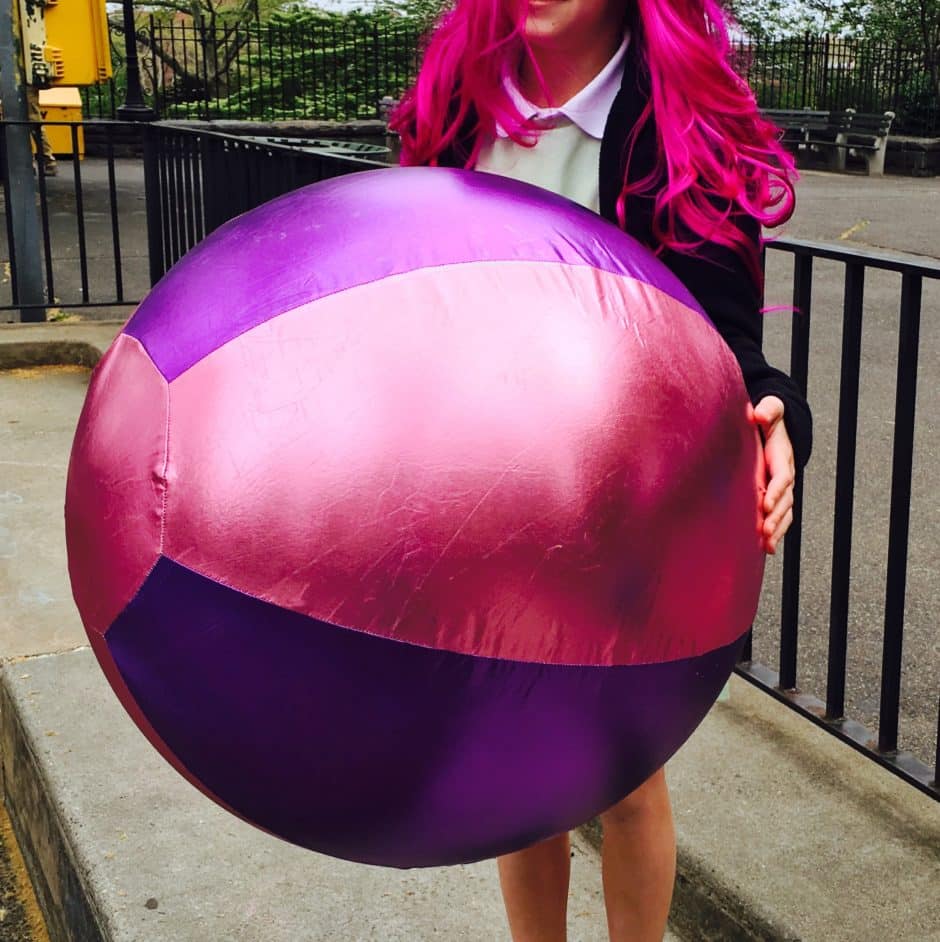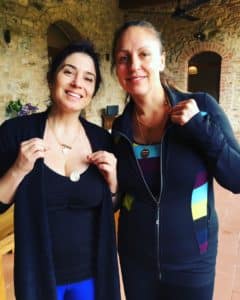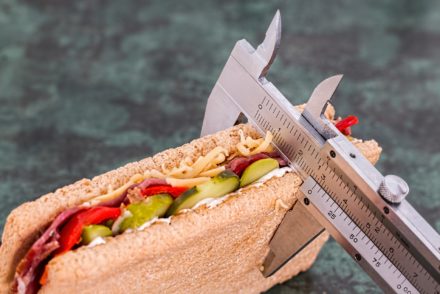By Maureen Langloss
One April several years ago, the grocery store near my daughter’s school displayed a bouquet of plastic balls in all shapes and sizes. Spring in round, inflatable form. A particular purple ball caught my eye as I passed to pick Ainsley up from kindergarten. Purple was Ainsley’s favorite color, her only color. The ball registered that first day. Enormous and impractical and unstore-able. I desired it the second. By the third, I was imagining it in my daughter’s tiny, growing hands. On the fourth, I couldn’t sleep with worry that this ball would be gone before I got to it, purchased by someone who wanted it more. But there it was still in the store window the next afternoon, practically glowing. Screaming “AAAHHHHHHHHH.”
I zipped the ball into a giant canvas bag, much like a magician hides the egg in his mouth. Ainsley filled to the brim with curiosity when she saw me carrying it. I opened the bag slowly, with great ceremony, as she peered inside.
“It’s Purple Ball Day!” I announced.
“Purple Ball Day!” she shrieked, like she already knew what that meant.
It was sunny, the air full of bloom. In an instant, we were in the playground with our new toy, which seemed to contain life inside its rubbery molecules. We rolled it, we kicked it, we tossed it as high as we could.
“To the clouds,” Ainsley said. “To the moon.”
The ball sailed over the fence and bumped more than one innocent bystander with its uncontrollability. Ainsley threw herself over top of it to tame it, pressing her stomach to the ball’s, rolling across the asphalt. Soon, a flock of children surrounded us, waiting a turn with this purple happy-maker.
As we left the playground, Ainsley said breathlessly, “Mom, put this in your calendar! We have to remember Purple Ball Day forever!”
And so, a mother-daughter holiday was born. My calendar now sends me reminders of Purple Ball Day just like it does for Easter.
***
When I was a child, my uncle, a Catholic priest, used to say Mass around our dining table. Seeing the wine turned to blood where you eat your mashed potatoes is both terrifying and lovely. It makes you feel like you’re only inches from God. And then, suddenly, you swallow Him and He’s rattling around in you, breaking down into glucose and truth that circulate to all your cells. Those were the kinds of things I thought about while my uncle consecrated the bread. Meanwhile, my agnostic dad used to sit outside on the porch, smoking cigarettes. His irreverent menthols became a part of the ritual too. His doubts about organized religion and the existence of God were like a beacon, smoke billowing into the sky.
I grew up going to Mass on Sundays (unless my mom overslept), singing in the church choir, and attending Confraternity of Christian Doctrine on Wednesdays (which has since traded up to the far more enticing moniker, “Narnia”). CCD mostly involved taking turns reading paragraphs from a dry religious textbook, and, for many of us, the public shaming of not yet reading aloud fluidly. Our priest was Father Stack, a grim confession-box of a man who did not smile when the occasion called for it and was far too tall to speak with children. You could see his shadow towering over you even through the black screen inside the actual confession box. As a child, I had precious few sins to relate. But the reconciliation process convinced me I must be teeming with them. Festering. A pus ball of sin.
I switched from public school to an Episcopal school in the ninth grade, and religion became a lot more uplifting. We had cathedral on Fridays and chapel on Wednesdays. Cathedral was God in a tux, and chapel was Cat Stevens in jeans. There was no transgression and reconciliation; instead the teachers set us loose to dream up poems in the cathedral’s many nooks and crannies, to write essays about the sculptures on the cathedral’s walls.
Wednesday chapel, dining table communion, and Christmas midnight Mass are among my most vivid childhood memories. I don’t remember what was said about Jesus so much as how each felt. There’s a Dutch word for it that my daughter’s Dutch godmother always uses: gazellig. In her book, Lost in Translation, Ella Frances Sanders describes it as “much more than just coziness – a positive warm emotion or feeling.” It “encompasses all of those things that make you cozy on the inside, like family, good conversations, and hugs.” The sound of an organ or the heft of a red prayer book in my hand will always return me to that gazellig place, fringed with a hint of Father Stack, CCD dictum, and cigarette smoke.
When I looked for my own family home a decade ago, I kept gravitating to apartments with views of churches. We now live across the street from a charming Episcopal version with a steeple on top and a slate roof in need of repair. In the spring, the church hosts a blessing of the animals, and people line up down the block with their poodles and terriers. Just beyond it, in full view from my apartment, is the back of a modern, circular-shaped synagogue. We look out on all kinds of God.
And yet somehow we never set foot in the church across the street. We schedule tennis and synchronized ice-skating practice for Sunday mornings, and we go to a church down the street for movies or to build Legos and make sandwiches for the homeless. We go to the synagogue for birthday parties.
We baptized our kids with all sorts of good intentions — not Catholic, mind you. We don’t go to Catholic church largely because I can’t stomach worshipping in a place that doesn’t allow women to be priests, where my daughters and I are made to feel like second-class pray-ers. But the woman priest who runs our Protestant church is all kinds of boring and we prop our eyes open during the sermon, which dwells a lot on asking for money. I suppose the church’s need to support itself in this time of dwindling religion is a reality I should accept and get over. Besides, God isn’t there for our entertainment. We are supposed to gather together to worship and submit to a higher power.
Worrying about the religious gaps in my parenting style, and with the hope of sparking our religious life, I took my eldest child on a pilgrimage to Rome for a family wedding the same year I bought that purple ball. It was, indeed, a mega-dose of organized religion: daily Mass, religious tours of the Vatican, the public audience with Pope Francis on St. Peter’s Square. But, when the father of the groom said in his toast at the rehearsal dinner that his one goal for his children had always been to get them into heaven, I nearly choked on my wine (not the transubstantiated kind). I’d worried about getting my kids into kindergarten, to college. But heaven? If there’s a Red Bull version of Catholic guilt, he delivered it directly into my central nervous system. That was some goal.
I thought about what I’ve done to help my kids’ heaven scorecard. We have a kindness tree, and sometimes we remember to stick a leaf on when they share a toy, say a caring word, or give of themselves. At dinner, I ask them what act of goodness they undertook that day. Were they brave? I teach them about social injustice and courage. They help with book and toy drives. We read stories like Wonder, Last Stop on Market Street, and Henry’s Freedom Box. Books about bullying, prejudice, poverty, standing up for what is right. I tell them about Jesus letting Mary Magdalene wash his feet. But, still, instead of taking them to Sunday school, I seem to do little more than buy them purple balls. I worried about this on our trip home from Rome.
***
The second anniversary of purple ball day coincided with the week I had knee surgery. Unable to go to the park, I filled Ainsley’s room with two dozen purple helium balloons and waited expectantly to welcome her home to the surprise. When the strings got wound together, my kids realized they could go inside the balloon-beast and wear it like protective gear. Picture the Fruit-of-the-Loom grapes. Even my son, a pre-teen who is often too cool for his sisters’ games, took a turn. The children spent the evening tossing themselves up in the air and soft-landing onto the balloons with pure, radiant joy. They became the ball themselves.
On the third anniversary, I arrived to school with an even bigger, shinier ball to match my girl’s rapidly growing body, her effervescent personality. I added a new twist: I wore a vibrant purple wig that came down to my waist. It took a moment for Ainsley to recognize me. When she did, her face transformed to unmitigated love. Her smile dropped to the floor and reached up to the ceiling. Complete and utter embarrassment followed soon after. Her humiliation doubled in size when I pulled out a wig for her too.
“No, Mom. No way. Absolutely not.”
“If I’m wearing one, you have to too.”
Ainsley reluctantly slipped into the tresses, and we walked the long hallway to the school exit. We crossed the street to the park, passing teachers and older kids, friends and security guards. But Ainsley didn’t shrink; she held her head high and laughed. She kept that wig on through a round of catch, and generously allowed her sister to use it the next day, a little sister who was so smitten with purple ball day that she demanded I arrive to her preschool in purple wig the next afternoon. It had started as Ainsley and my special tradition, and now it was the whole family’s.
The ball seems to have a life of its own. We find it in different rooms of the apartment, not quite sure how it traveled from here to there. The dog is petrified of it, my husband irked by it. Sometimes it reminds me of my own writing, of how words bounce where you don’t expect and break things. Sometimes it gets in the way. It looks messy. Other times, it’s an irresistible force. My kids can’t help but hop aboard, feel its buoyant lift, dribble it down the hall.
There is an inherent simplicity about tossing a round object back and forth, back and forth, sending connection from me to you and you to me, grounding us to this moment, to each other. We can’t be competitive with a big round ball; it’s too unwieldy to be dominated, to show off with. When you bounce it, there’s a sound inside the sound, a shudder of vulnerability. I could pop, the ball seems to say. Play too hard, and you will break me. Take care of me, it says.
Looking at the ball now, I realize that the heaven scorecard is too reductive. Another achievement rubric, complete with perfect Sunday School attendance, will not help me raise good people. And good people is what I strive for. I hope my children are never afraid to welcome a Mary Magdalene, to protect others from bullies, to fight for social justice and freedom and against racism and sexism, to care for the sick and needy and loved ones. I hope they seize life with joy and daring and eccentricity. I hope they don’t cower from looking at the world from different perspectives, from letting themselves get uncomfortable, from doubting and believing. It isn’t Mass and it isn’t Narnia, but Purple Ball Day is our family ritual, our gazellig. God lives inside that giant ball too. I’m teaching my kids how to reach for grace, one toss at a time.
Maureen Langloss is a lawyer-turned-writer living in New York City. She serves as the Flash Fiction Editor at Split Lip Magazine and as a nonfiction reader at The Indianola Review. Her work has appeared in Bird’s Thumb, (b)OINK, Jellyfish Review, Literary Mama, Necessary Fiction, the Prairie Schooner blog, The Timberline Review, Wigleaf, and elsewhere.

Join Jen Pastiloff at her signature workshop in Atlanta at Form Yoga on Aug 26 by clicking the picture.






No Comments